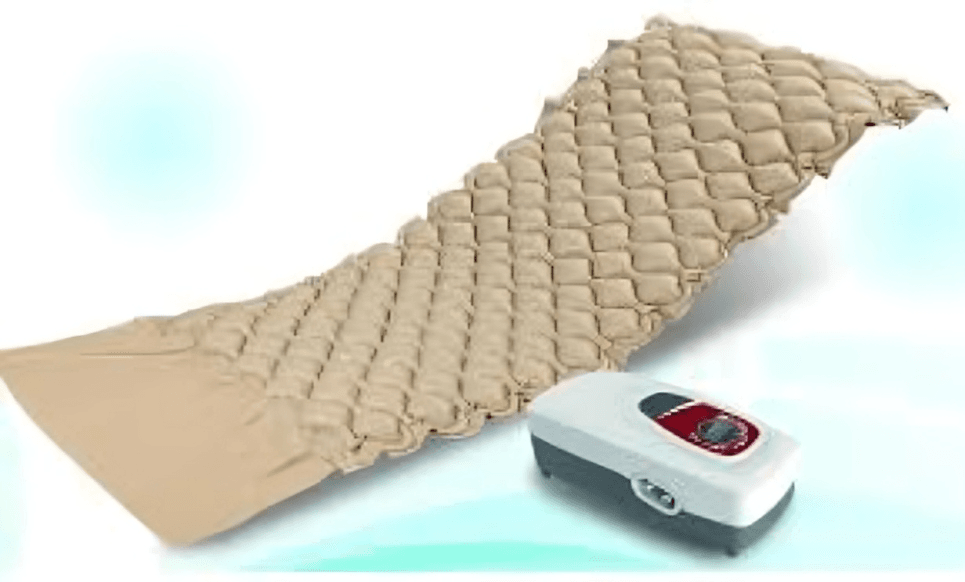Introduction
A ripple mattress is a specially designed medical mattress that helps prevent pressure ulcers and enhances patient comfort. It is commonly used for individuals who are bedridden, recovering from surgery, or have limited mobility. Ripple mattress uses include reducing pressure on the skin, promoting better blood circulation, and minimizing the risk of bedsores by alternating pressure. These mattresses are ideal for home care, hospitals, and nursing homes, ensuring long-term patient support and improved recovery.
A ripple mattress is an excellent solution for preventing bedsores and enhancing comfort. If you’re looking for a high-quality ripple mattress, check out this premium ripple mattress designed for maximum support and durability.
Ripple mattresses are becoming an essential part of patient care in hospitals, nursing homes, and personal residences. If you or your loved one spends long hours in bed, understanding the uses and benefits of a ripple mattress can make a significant difference in overall health and comfort.
1. What is a Ripple Mattress?
A ripple mattress is a medical-grade air mattress designed to prevent pressure sores and enhance comfort for individuals who remain in bed for extended periods. Unlike traditional foam or spring mattresses, ripple mattresses use air cells that inflate and deflate in cycles, reducing constant pressure on any single body area.
Key Features of a Ripple Mattress:
- Alternating Pressure Mechanism – Helps redistribute body weight evenly.
- Air Cell Design – Multiple interconnected air pockets that move dynamically.
- Adjustable Pressure Levels – Customizable comfort settings for patients.
- Silent Air Pump System – Maintains quiet operation for undisturbed rest.
These features make ripple mattresses an essential tool in medical settings, home care, and elderly patient management.
2. How Does a Ripple Mattress Work?
Ripple mattresses use a system of air cells that continuously inflate and deflate, creating a shifting support system for the body. This technology prevents prolonged pressure on any single body part, reducing the risk of bedsores and discomfort.
Key Working Mechanisms:
- Air Pump System – A small motorized pump regulates air pressure and ensures constant air circulation.
- Alternating Air Flow – Air moves in cycles, shifting pressure from one area to another.
- Customized Comfort Settings – Users can adjust pressure levels based on their needs.
- Prevention of Skin Breakdown – By keeping pressure off certain areas, the mattress helps maintain healthy skin.
For individuals who remain in one position for long periods, this mechanism is crucial in preventing pressure ulcers and improving sleep quality.
3. Types of Ripple Mattresses
There are several types of ripple mattresses available, each designed for specific patient needs.
Static Ripple Mattress
- Does not have an alternating air system.
- Provides a stable surface with pressure distribution.
- Best suited for mild cases of immobility.
Alternating Pressure Ripple Mattress
- Uses a motorized pump to alternate pressure cycles.
- Ideal for patients at high risk of developing bedsores.
- Commonly used in hospitals and nursing homes.
Hybrid Ripple Mattress
- Combines foam and air cell technology.
- Offers both stability and pressure relief.
- Recommended for long-term use in home healthcare settings.
4. Ripple Mattress Uses
Ripple mattresses are versatile and serve different purposes in healthcare and home settings.
For Bedridden Patients
Patients who are permanently or temporarily bedridden are at high risk of developing pressure sores. A ripple mattress continuously shifts pressure, keeping the skin healthy.
For Elderly People
As aging reduces skin elasticity and blood circulation, elderly individuals benefit from the gentle massage-like effect of ripple mattresses, preventing pain and discomfort.
For Post-Surgical Recovery
After surgery, patients may need extended bed rest. A ripple mattress helps distribute weight evenly, reducing strain on surgical wounds and enhancing recovery.
For Individuals with Limited Mobility
People with conditions like paralysis, stroke recovery, or severe arthritis benefit from ripple mattresses, which provide essential support and reduce muscle stiffness.
For Home Healthcare and Hospital Use
Ripple mattresses are widely used in hospitals, nursing homes, and home healthcare setups to enhance patient comfort and prevent long-term complications related to immobility.
5. Key Benefits of Using a Ripple Mattress
Ripple mattresses offer numerous benefits beyond just comfort.
Prevention of Pressure Sores and Ulcers
- Redistributes weight to reduce constant pressure on specific areas.
- Lowers the risk of skin breakdown, especially in bedridden patients.
Improved Blood Circulation
- Alternating pressure encourages better blood flow, reducing swelling and numbness.
- Helps prevent conditions like deep vein thrombosis.
Enhanced Comfort and Sleep Quality
- Patients experience fewer disturbances due to body aches.
- Customizable pressure settings allow for personalized comfort.
Reduction of Pain and Discomfort
- The air mattress absorbs body weight, reducing pain in joints and muscles.
- Ideal for patients with arthritis or post-surgical pain.
Easy Maintenance and Cleaning
- Most ripple mattresses come with waterproof, antibacterial covers.
- Simple to clean, making it a hygienic option for patient care.
6. Ripple Mattress vs. Regular Mattress
When comparing a ripple mattress to a traditional mattress, the differences are clear, especially in terms of comfort and health benefits.
Key Differences Between Ripple and Regular Mattresses
| Feature | Ripple Mattress | Regular Mattress |
|---|---|---|
| Pressure Relief | Alternating pressure prevents bedsores | Provides constant pressure, leading to sores |
| Comfort Level | Adjustable air pressure for personalized comfort | Standard firmness, may not suit medical needs |
| Blood Circulation | Improves circulation by shifting pressure | Can restrict circulation over time |
| Best For | Bedridden, elderly, post-surgery patients | General sleep comfort |
| Price | Higher cost due to advanced technology | More affordable options available |
A ripple mattress is designed for therapeutic benefits, making it a superior choice for those with limited mobility or medical conditions. In contrast, a regular mattress is more suited for general sleep purposes without medical considerations.
7. Choosing the Right Ripple Mattress
When selecting a ripple mattress, consider durability, comfort, and ease of use. Our best-selling ripple mattress offers all these features at an affordable price.
Factors to Consider When Buying a Ripple Mattress
- Weight Capacity – Ensure the mattress supports the user’s body weight.
- Mattress Size – Choose based on hospital bed size or home bed compatibility.
- Type of Mattress – Decide between static, alternating pressure, or hybrid models.
- Material Quality – Look for medical-grade, antibacterial, and waterproof materials.
- Pump Noise Level – Opt for a quiet motor to ensure restful sleep.
- Portability & Storage – Lightweight and easy-to-fold options are ideal for home use.
- Budget & Warranty – Compare pricing and warranty options for long-term value.
Best Choice for Different Users
- For bedridden patients → Alternating pressure mattress
- For elderly individuals → Hybrid mattress with foam support
- For hospitals → Advanced models with remote-controlled settings
- For home care → Lightweight, easy-to-clean models
Choosing the right ripple mattress can significantly impact the user’s comfort and health, so investing in a quality product is essential.
8. How to Use a Ripple Mattress Properly
To get the most out of a ripple mattress, proper setup and maintenance are key.
Installation and Setup
- Unpack the Mattress – Lay it flat on the bed frame.
- Connect the Air Pump – Attach the pump to the mattress using the provided tubing.
- Power On the System – Plug in the air pump and turn it on.
- Adjust the Pressure Settings – Modify according to the patient’s needs.
- Position the Patient Comfortably – Ensure they are lying in a neutral position.
Tips for Maximum Efficiency
- Check air pressure daily to maintain optimal support.
- Ensure there are no leaks in the air cells to prevent deflation.
- Place a light sheet over the mattress for hygiene and comfort.
- Avoid sharp objects nearby to prevent accidental punctures.
Regular maintenance ensures a ripple mattress lasts longer while providing consistent medical benefits.
9. Potential Downsides of Ripple Mattresses
While ripple mattresses offer numerous benefits, they also come with some drawbacks.
1. Cost Considerations
- Ripple mattresses are more expensive than standard foam mattresses.
- High-end models with advanced features can be costly.
2. Noise Levels from the Air Pump
- Some air pumps create a low humming sound, which may disturb light sleepers.
- Newer models are quieter, but older versions can still produce noticeable noise.
3. Compatibility Issues
- Not all ripple mattresses fit standard bed frames.
- Hospital-grade models may require specialized bed bases.
Despite these downsides, the medical benefits far outweigh the disadvantages for individuals with mobility issues.
10. Best Ripple Mattress Brands in the Market
When buying a ripple mattress, choosing a reputable brand ensures quality and durability.
Top Ripple Mattress Brands & Their Features
- Drive Medical Alternating Pressure Mattress
- Silent air pump with adjustable settings
- Durable, waterproof, and easy to clean
- Ideal for hospital and home use
- Buy Now
- Invacare Softform Premier Mattress
- Hybrid foam and air cell design
- Pressure-relief support for high-risk patients
- Premium comfort with long-lasting durability
- MedVance Alternating Pressure Mattress
- Budget-friendly option with strong air cell construction
- Lightweight and easy to set up
- Best for short-term use after surgery
Where to Buy Ripple Mattresses?
- Medical Supply Stores – Best for expert recommendations and after-sales service.
- Online Retailers (AfyaMed Supplies, Crown Healthcare etc.) – Offers a variety of options with customer reviews.
- Hospital Equipment Suppliers – Provides hospital-grade ripple mattresses with warranties.
When purchasing, always check customer reviews and warranty policies to ensure a quality product.
Conclusion
A ripple mattress is a game-changer for individuals with limited mobility, bedridden patients, and elderly individuals. It helps prevent pressure sores, improves blood circulation, and enhances sleep quality. Whether used in hospitals or home care, it offers a reliable solution for long-term patient comfort.
When selecting a ripple mattress, consider factors like size, material, noise levels, and weight capacity. Investing in a good-quality ripple mattress ensures comfort, durability, and improved overall health.
If you or a loved one needs extra support while sleeping, a ripple mattress is a worthwhile investment for better care and comfort.
FAQs
1. How long should a patient use a ripple mattress?
A ripple mattress can be used indefinitely for patients with long-term mobility issues. For post-surgical recovery, usage may vary from a few weeks to several months, depending on the doctor’s recommendation.
2. Can a ripple mattress be used on any type of bed frame?
Most ripple mattresses are designed for hospital beds but can also be used on regular bed frames as long as they fit properly. Always check the size specifications before purchasing.
3. Is a ripple mattress safe for elderly individuals?
Yes, ripple mattresses are highly beneficial for elderly individuals, especially those prone to bedsores or poor circulation. They provide enhanced comfort and reduce pressure-related discomfort.
4. What is the lifespan of a ripple mattress?
The average lifespan of a ripple mattress ranges from 2 to 5 years, depending on the quality, usage, and maintenance. Regular cleaning and checking for leaks can extend its durability.
5. How do I clean and maintain a ripple mattress?
Use a mild disinfectant to clean the mattress surface regularly. Ensure the air pump and tubes are free from dust and moisture. Avoid using sharp objects near the mattress to prevent punctures.


0 Comments